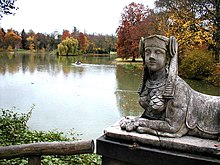Johann Sebastian Barnabas Pfaff
Johann Sebastian Barnabas Pfaff (baptized June 11, 1747 in Obertheres ; † March 30, 1794 in Mainz) was a German sculptor of the 18th century.
Life
Pfaff was born the son of the carpenter Johann Christoph Pfaff († 1767). He did his training in the workshop of Johann Thomas Wagner ; He received further training in Bamberg. His brothers were also sculptors. He moved to Bruchsal as early as 1771 . On June 25, 1777, he married the Bruchsal doctor's daughter Maria Apollonia Nagel in the Bruchsal Court Church. In the same year he became a citizen of Mainz and a member of the sculptors' guild. In 1786 he worked with Georg Scholl in Koblenz, where he created the electoral coat of arms on the pillar of the Rhine facade of the palace, two lions on the stairs in the western hall and four lions on the wall in front of the courtyard. Pfaff died in Mainz in 1794. His widow married Georg Scholl in the same year and thus enabled the sculpture town to continue.
reception
Ernst Neeb said that an honorable place will surely be granted to him. Berthold Tapp believes that he was undoubtedly an artist of considerable rank and his works were an ornamental Mainz Churches and representative buildings.
Works
- 1772: Epitaph for the Baron von Limburg-Stirum in St. Peter's Church in Bruchsal
- 1786: Relief of the electoral coat of arms with the allegory of the Rhine and Moselle on the pillar of the Rhine facade of the castle in Koblenz as well as two lions on the stairs in the western hall and four lions on the wall in front of the courtyard
- 1789/90: Four red sandstone sphinxes on the Red Bridge in Schönbusch Park in Aschaffenburg (removed and replaced with replicas)
- 1788: Four wooden sculptures in the Temple of Friendship in Schönbusch Park in Aschaffenburg
- 1792: Amorbach Monastery , Green Hall, stucco decoration - cycle of seasons: winter, spring, summer, autumn
- 1792: Amorbach Monastery, Green Hall, stucco decoration - cycle of elements: water, fire, air, earth
- Brozzetti of St. Nicolaus of Bari and St. Valentin, executed as sculptures on the portal of the Christopherus Church in Mainz
- Allegory of architecture, brozzetto and sandstone figure (the latter today without a head) from the former Mainz Cathedral Provostei
- Allegory of garden art, brozzetto and sandstone figure (the latter today without a head) from the former Mainz cathedral provost
- Allegory of the sculpture made of gray sandstone, probably also from the former provost office of the Landesmuseum Mainz, inv. No. S 3174
The most important works also include the other statues that Pfaff created for the Dompropstei, but which were completely destroyed and lost during the siege and bombardment of Mainz in 1793 .
literature
- Karl Bischoff: Johann Sebastian Barnabas Pfaff, a sculptor in Mainz , dissertation, University of Frankfurt, July 30, 1927.
- Pfaff, Sebastian (Joh. Seb. Barnabas) . In: Hans Vollmer (Hrsg.): General lexicon of fine artists from antiquity to the present . Founded by Ulrich Thieme and Felix Becker . tape 26 : Olivier – Pieris . EA Seemann, Leipzig 1932, p. 520 .
- Landesmuseum Mainz: Goethe: The Siege of Mainz 1793 Causes and Effects, Exhibition Catalog, Mainz March 28 to May 30, 1993
- Main-Post from December 23, 2005: An almost forgotten artist
Individual evidence
| personal data | |
|---|---|
| SURNAME | Pfaff, Johann Sebastian Barnabas |
| ALTERNATIVE NAMES | Pfaff, Sebastian |
| BRIEF DESCRIPTION | German sculptor |
| DATE OF BIRTH | baptized June 11, 1747 |
| DATE OF DEATH | March 30, 1794 |
| Place of death | Mainz |
